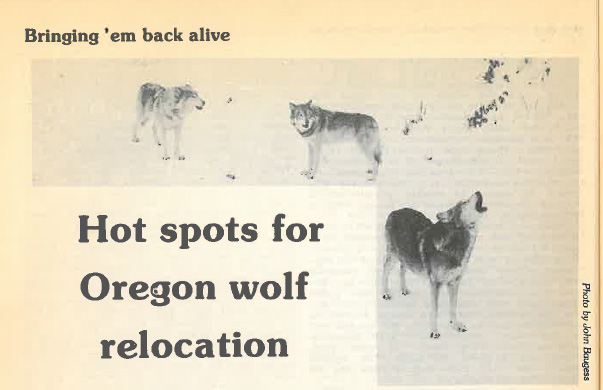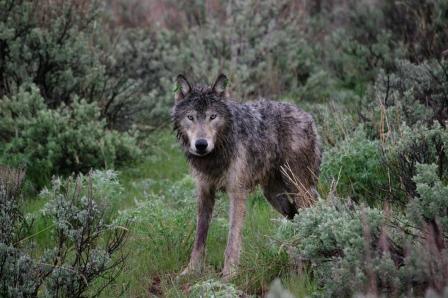
By Beth Krynick
At one time, gray wolves inhabited much of Oregon. Unfortunately, by the late 1940s, a very deliberate campaign had eradicated this iconic species from the state.
It would be more than a half a century before gray wolves would return in earnest. However, before wolves showed up on their own, the US Fish and Wildlife Service had actually considered a plan to translocate them back into the state. A spring of 1984 Wild Oregon newsletter features a summary of the proposal to re-introduce wolves along with a list of potential sites.

Three points featured in the USFWS proposal to re-reintroduce wolves in Oregon:
- The location needed to have a low human and livestock population to minimize conflicts,
- The need for large blocks of public land with significant ungulate populations, the size of which will help determine the carrying capacity for wolves and,
- Public and governmental support which are a must if a re-introduction project is going to be successful.
In 1984, re-introducing wolves into the Oregon wilderness was a fairly new concept, and location, support, and reducing conflict were emphasized as necessary to provide for a success of translocation.
In South Carolina, a similar translation experiment with red wolves had been conducted in January, 1976. The results seemed promising. Two red wolves were released onto Bull’s Island, which is a part of the Cape Romain National Wildlife Refuge in South Carolina. The two wolves were seen staying together, catching prey, gaining weight, and were also thought to have given birth. Unfortunately, the pups were presumed dead because of hookworms or other parasites.

While the results of the experiment were questionable, it successfully convinced the public and federal biologists that wolf translocations were indeed possible. This set the bar for wolf re-introduction in Oregon, where USFWS began scoping out potential sites for the wolf population. Out of dozens of potential sites, the regions chosen included Klamath Mountains Zone, Central Cascade Zone, Southern Cascade Zone, North Fork John Day Zone and Hells Canyon Zone.
After the zones were chosen, the next logical step was to re-introduce ecological communities in order for a thriving eco-system. The plan never went forward, and Oregon would still have to wait 20 years before wolves would begin to reestablish themselves on their own.
Lois Crisler, Author of Arctic Wild, said, “Without the animals, the land is dead.” That statement holds truth, even more so today. Perhaps with the gradual return of this iconic species, our land is just a little more alive.
As of February 2015, there are 77 confirmed wolves in nine packs whose used and assumed locations can be seen on the map from the Oregon Department of Fish and Wildlife (ODFW).
Click here to read more on the return of wolves to Oregon.
Want to stand up for Oregon’s wolves? Click here!


